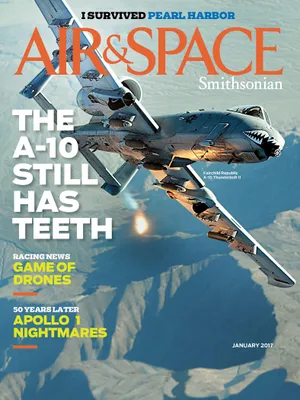Complacency in the Cockpit
A human factors expert discusses the subtle dangers facing today’s airline pilots.
/https://tf-cmsv2-smithsonianmag-media.s3.amazonaws.com/filer/03/b7/03b7dcfa-9632-43fb-9369-8779885b5294/33a_dj2017_tonykern_live.jpg)
Tony Kern, who flew B-1Bs for the U.S. Air Force, is the CEO of Convergent Performance, a company that works to reduce human error in high-risk environments such as aviation, military operations, and law enforcement. A former chairman of the Air Force Human Factors Steering Group, Kern has written several books, including Flight Discipline and Darker Shades of Blue: The Rogue Pilot.
Air & Space: What is the most pressing human factors issue regarding commercial airline pilots?
Kern: There are several human factors issues that need near-term attention, but if you forced me to identify the most pressing of these it is how the industry is handling the largest generational handoff in the history of our industry—or any industry for that matter. Due to several factors—primarily 9/11, the global economic crises, and the age 65 rule—we lost a generation of new hires during the associated furloughs and hiring freeze. The good news from this is that we now have the most experienced pilot force we have ever had—and will ever have in our industry. The bad news is that this experience is rapidly aging out of the industry, and being replaced by talented, but far less experienced aircrew.
Has the increasing digital presence in airline cockpits lead to pilots being unprepared to handle emergencies?
I guess the answer to that question depends on the nature of the emergency. Technology has made our industry much safer, no question about that. But technology can also mask deteriorating situations from the pilot’s awareness and cascade a single error into a tragic situation. Hand flying proficiency must be maintained, and I think we need an expanded human factors training program that includes a strong component of automation airmanship. Let’s face it, the airline pilot remains the first and last line of defense for safe operations, and data input and verification skills are now as important as knowing how to land in a crosswind.
What does it mean when a pilot “gets behind” his or her aircraft?
Far too often, pilots allow automation to make decisions for them, and lose track of what is going on. A classic example of this was American Airlines Flight 965, where [in 1995] the crew crashed into a mountain in Colombia. They were descending, at night, in mountainous terrain, and didn’t know where they were. A simple decision to climb back to a safe altitude and figure it out would have saved them, but they had gotten behind the aircraft. A pilot should never let an airplane go somewhere his or her mind hasn’t already arrived at a few minutes—or at least a few seconds—earlier.
Are there lessons learned from the training of military pilots that could be useful for airline pilots?
Sure, but this also works in the other direction. Let me give you a couple of examples. I think military pilots do a much better job of briefing and debriefing for lessons learned. On the flip side, I think the airlines do a better job of training to standards. When you think about it, it’s amazing that these pilots show up 45 minutes before a flight, meet someone they have never flown with before, and conduct hundreds of thousands of flights every year with nearly zero mishaps. There is a lot of sensitivity in the commercial industry about adopting military lessons. I don’t really get this attitude, but it is definitely there.
Forest-fire suppression missions: Is this one of the most demanding and volatile environments a pilot can fly in?
I was the National Aviation Officer for the U.S. Forest Service for five years, and I have to say, I have never seen a group of aviators as dedicated to performing their mission in such a chaotic and high-risk environment. What is even more impressive, is that they do it with technology from the 1950s and ’60s. The fire seasons used to last four or five months, but the conditions of the forests in America now dictate a year-round response capability. This puts a real strain on the pilots, maintenance teams, and the entire system. It’s time the nation realizes we need to put some serious resources into aerial firefighting if we want to continue to protect our natural resources and the citizens who live in or near them.
What is your opinion of the B-1?
The Bone [a nickname for the B-1] is an incredible jet, the Ferrari of large aircraft. My Bone brothers probably won’t admit it, but it’s really easy to fly. Tremendously responsive in both power and maneuverability. It’s turned out to be the backbone of the bomber fleet and I hope it stays in the inventory for decades to come. It can get to places fast, and deliver devastating firepower upon arrival. No other aircraft in the world can do what it does.
What do you see for aviation’s future?
I’ve been around aviation now for over four decades and am proud that other industries consider us the gold standard for operational effectiveness and safety. But recently, I’ve sensed we might be resting on our laurels and allowed our great record to speak for itself. We did not get [a stellar safety record] by thinking this way, and we need to do more than study data and correct deficiencies to stay ahead of the curve. We need free thinkers, innovators, operators, maintainers, and regulators to think boldly to drive us to the next level. That is who we are—or at least were—as aviation professionals.
